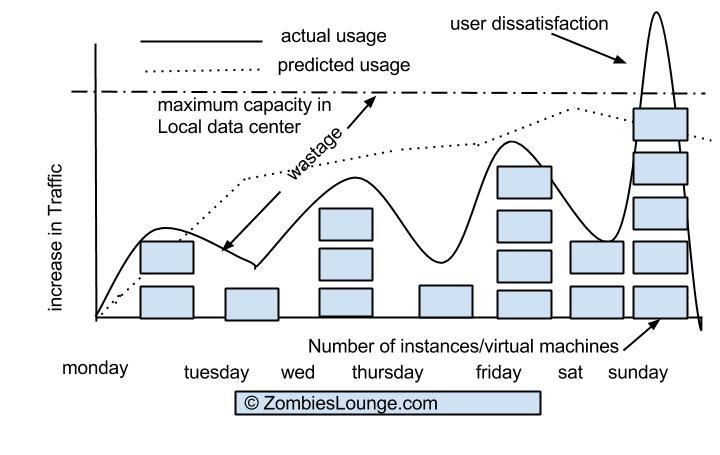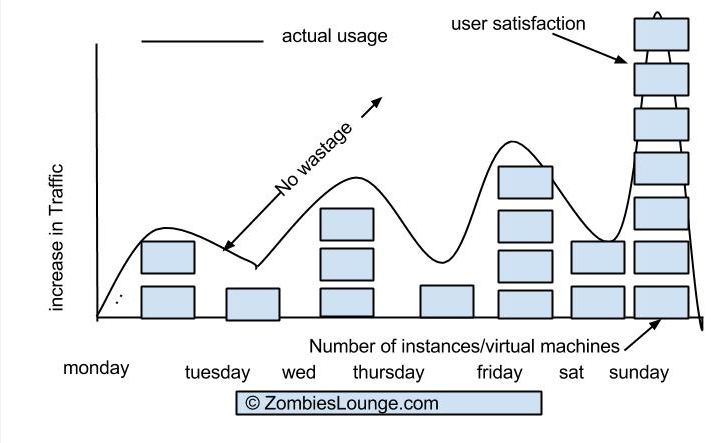Companies have started the cloud migration because of many reasons. Following advantages clearly tell you that the “Cloud is the future of IT infrastructure”.
- Pay for what you use: Traditional Datacenters need big upfront investment to implement and maintain it. But cloud services are provided for zero upfront cost. Users can pay for what they use and how much they use. For example, 1000 users are visiting the website in a specific time, the cloud customer will be charged $1 per hour, if 10,000 users are visiting the website simultaneously, customer will be charged $10 per hour.
- Scalability: Customers can “scale up” and “scale down” their resources such as Instance/Virtual Machine size (CPU+RAM+STORAGE) whenever they want.
Auto Scaling: As per the below diagram, when a company wants to set up a traditional local data center, they predict their future usage of their services and plan the datacenter accordingly. But, sometimes the usage won’t be as per the prediction and may exceed the predicted usage. In the example diagram below, users will be dissatisfied about the service if the website is slow at the peak usage time of your service.
Cloud Auto Scaling solves this: But in the cloud, you can see the number of virtual machines/servers automatically increased and decreased as per the traffic to your website and traffic is distributed equally between those virtual machines.
You will be charged for what you use.
- Easy Deployment: Deploying in the cloud is very easy and just the matter of clicks. No worries about hardware failure and network downtimes like traditional data center.
- Low Latency: We can use the Content Delivery Networks (CDN) of cloud to serve our users faster. For example, a web site is hosted in Oregon, USA data center. But they have customers also in Europe. So, they can simply sync the data in all the Europe cache (edge) servers. Now, users from France will download the 98% of the web site data from “Paris” cache server of the cloud service provider. Users can also use technologies like memcached in cloud with few clicks. This will increase the database operation speed many folds. So the overall application speed will be faster.
- Easy Disaster Recovery: In cloud, It is easy to set up failovers. For example, Server failure can be solved using load balancers and database failover configuration also need just one-click setup.
- Big Data analytics: Organizations can use ready made Big data and Analytics infrastructure solutions currently available in the cloud to get the benefits of Big Data. You can also refer Amazon Elastic MapReduce.
- Less Manpower: Small team of IT engineers can manage a big public cloud infrastructure easily.
- Security: Cloud service providers are using cutting edge technologies in their data centers. When it comes to “Security in the cloud” we have some concerns. But, cloud data centers normally follow security standards. Amazon even provides GovCloud for the customers who are concerned about the different security compliance.
- High Durability Storage: Storage in the cloud is highly durable. They are backed up/replicated in multiple location for disaster recovery.
- Access Management and Monitoring: Cloud service providers created an easy web based management consoles. Using that a company can manage their cloud infrastructure easier and allow colleagues to access the cloud console with limited permissions. For example, I can provide database read-only access to one of my colleague and DNS console access to my other colleague. But the super user will have the access to all the cloud resources like Compute, Storage, Networking and Database and other additional products. We can easily see the statistics about our cloud resource utilization and we can create alarms that will alert us through email when a threshold limit is reached.



